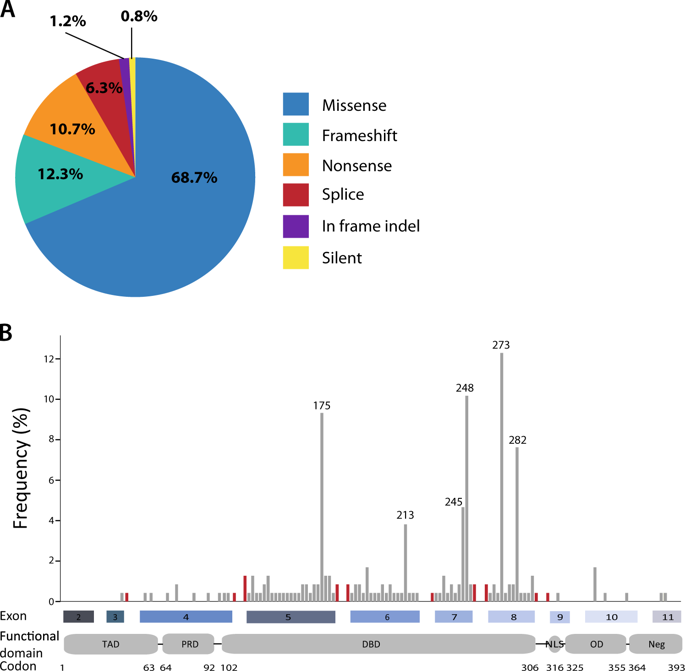当前位置:
X-MOL 学术
›
Oncogenesis
›
论文详情
Our official English website, www.x-mol.net, welcomes your
feedback! (Note: you will need to create a separate account there.)
Transcriptional and functional consequences of TP53 splice mutations in colorectal cancer.
Oncogenesis ( IF 5.9 ) Pub Date : 2019-05-15 , DOI: 10.1038/s41389-019-0141-3 Jørgen Smeby 1, 2, 3, 4 , Anita Sveen 1, 2, 4 , Ina A Eilertsen 1, 2, 4 , Stine A Danielsen 1, 2 , Andreas M Hoff 1, 2 , Peter W Eide 1, 2 , Bjarne Johannessen 1, 2, 4 , Merete Hektoen 1, 2 , Rolf I Skotheim 1, 2 , Marianne G Guren 2, 3 , Arild Nesbakken 2, 4, 5 , Ragnhild A Lothe 1, 2, 4
Oncogenesis ( IF 5.9 ) Pub Date : 2019-05-15 , DOI: 10.1038/s41389-019-0141-3 Jørgen Smeby 1, 2, 3, 4 , Anita Sveen 1, 2, 4 , Ina A Eilertsen 1, 2, 4 , Stine A Danielsen 1, 2 , Andreas M Hoff 1, 2 , Peter W Eide 1, 2 , Bjarne Johannessen 1, 2, 4 , Merete Hektoen 1, 2 , Rolf I Skotheim 1, 2 , Marianne G Guren 2, 3 , Arild Nesbakken 2, 4, 5 , Ragnhild A Lothe 1, 2, 4
Affiliation

|
TP53 mutations are common in colorectal cancer (CRC). Most TP53 sequencing studies have been restricted to coding regions, but recent studies have revealed that splice mutations can generate transcript variants with distinct tumorigenic and prognostic properties. Here, we performed unrestricted sequencing of all coding sequences and splice regions of TP53 in a single-hospital series of 401 primary CRCs. TP53 splice mutations were detected in 4% of the cases (N = 16), considerably more frequent than reported in major databases, and they were mutually exclusive to exon mutations. RNA sequencing revealed high-level expression of aberrant transcript variants in the majority of splice mutated tumors (75%). Most variants were predicted to produce truncated TP53 proteins, including one sample expressing the potentially oncogenic and druggable p53ψ isoform. Despite heterogeneous transcript structures, downstream transcriptional profiling revealed that TP53 splice mutations had similar effects on TP53 target gene expression and pathway activity as exonic mutations. Intriguingly, TP53 splice mutations were associated with worse 5-year relapse-free survival in stage II disease, compared to both TP53 wild-type and exon mutations (P = 0.007). These data highlight the importance of including splice regions when examining the biological and clinical consequences of TP53 mutations in CRC.
中文翻译:

TP53剪接突变在大肠癌中的转录和功能后果。
TP53突变在大肠癌(CRC)中很常见。多数TP53测序研究仅限于编码区,但最近的研究表明,剪接突变可产生具有不同致瘤和预后特性的转录变体。在这里,我们对401个主要CRC的单医院系列中TP53的所有编码序列和剪接区进行了无限制测序。TP53剪接突变在4%的病例中被检测到(N = 16),比主要数据库中报道的频率要高得多,并且与外显子突变互斥。RNA测序显示在大多数剪接突变的肿瘤中(75%)高表达异常转录物变体。预计大多数变体会产生截短的TP53蛋白,包括一份表达潜在致癌和可药物化的p53ψ同工型的样品。尽管有不同的转录本结构,但下游转录谱分析显示,TP53剪接突变对TP53靶基因表达和途径活性的影响与外显子突变相似。有趣的是,与TP53野生型和外显子突变相比,TP53剪接突变与II期疾病的5年无复发生存期较差有关(P = 0.007)。这些数据突出了在检查CRC中TP53突变的生物学和临床后果时,包括剪接区的重要性。与TP53野生型和外显子突变相比,TP53剪接突变与II期疾病的5年无复发生存率差相关(P = 0.007)。这些数据突显了在检查CRC中TP53突变的生物学和临床后果时,包括剪接区的重要性。与TP53野生型和外显子突变相比,TP53剪接突变与II期疾病的5年无复发生存率差相关(P = 0.007)。这些数据突出了在检查CRC中TP53突变的生物学和临床后果时,包括剪接区的重要性。
更新日期:2019-11-18
中文翻译:

TP53剪接突变在大肠癌中的转录和功能后果。
TP53突变在大肠癌(CRC)中很常见。多数TP53测序研究仅限于编码区,但最近的研究表明,剪接突变可产生具有不同致瘤和预后特性的转录变体。在这里,我们对401个主要CRC的单医院系列中TP53的所有编码序列和剪接区进行了无限制测序。TP53剪接突变在4%的病例中被检测到(N = 16),比主要数据库中报道的频率要高得多,并且与外显子突变互斥。RNA测序显示在大多数剪接突变的肿瘤中(75%)高表达异常转录物变体。预计大多数变体会产生截短的TP53蛋白,包括一份表达潜在致癌和可药物化的p53ψ同工型的样品。尽管有不同的转录本结构,但下游转录谱分析显示,TP53剪接突变对TP53靶基因表达和途径活性的影响与外显子突变相似。有趣的是,与TP53野生型和外显子突变相比,TP53剪接突变与II期疾病的5年无复发生存期较差有关(P = 0.007)。这些数据突出了在检查CRC中TP53突变的生物学和临床后果时,包括剪接区的重要性。与TP53野生型和外显子突变相比,TP53剪接突变与II期疾病的5年无复发生存率差相关(P = 0.007)。这些数据突显了在检查CRC中TP53突变的生物学和临床后果时,包括剪接区的重要性。与TP53野生型和外显子突变相比,TP53剪接突变与II期疾病的5年无复发生存率差相关(P = 0.007)。这些数据突出了在检查CRC中TP53突变的生物学和临床后果时,包括剪接区的重要性。











































 京公网安备 11010802027423号
京公网安备 11010802027423号